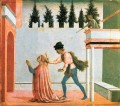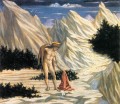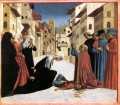Artists
Domenico Veneziano
- Country:
- Italy
- Birth year:
- 1410
- Death year:
- 1461
It is assumed that Domenico Veneziano (ca. 1410 Venice-1451 Florence), born Domenico di Bartolomeo da Venezia, was trained in the late Gothic tradition of northern Italy. By the 1430s he was at work in Perugia, but settled in Florence around 1440 after successfully applying for commissions from Piero de' Medici (1416-1469). Although Domenico Veneziano was inspired by the techniques of spatial and figural representation developed by Masaccio, Paolo Uccello and Andrea del Castagno, his greates interest lay in the expressive value of color, and he enriched early Florentine Renaissance painting with the transparency of his paints, becoming the first artist to reproduce atmospheric light. He created glowing and delicate gradations of color by increasing the amount of the oil used as a vehicle. Among his most famous students was Piero della Francesca, who worked together with the master in his studio. Major works by the artist include The Adoration of the Magi, c. 1433, Gemaldegalerie, SMPK, Berlin; Frescoes of the Virgin, c. 1440, San Egidio, Florence; and The Annunciation, c. 1442-1448, The Fitzwilliam Museum, Cambridge.






